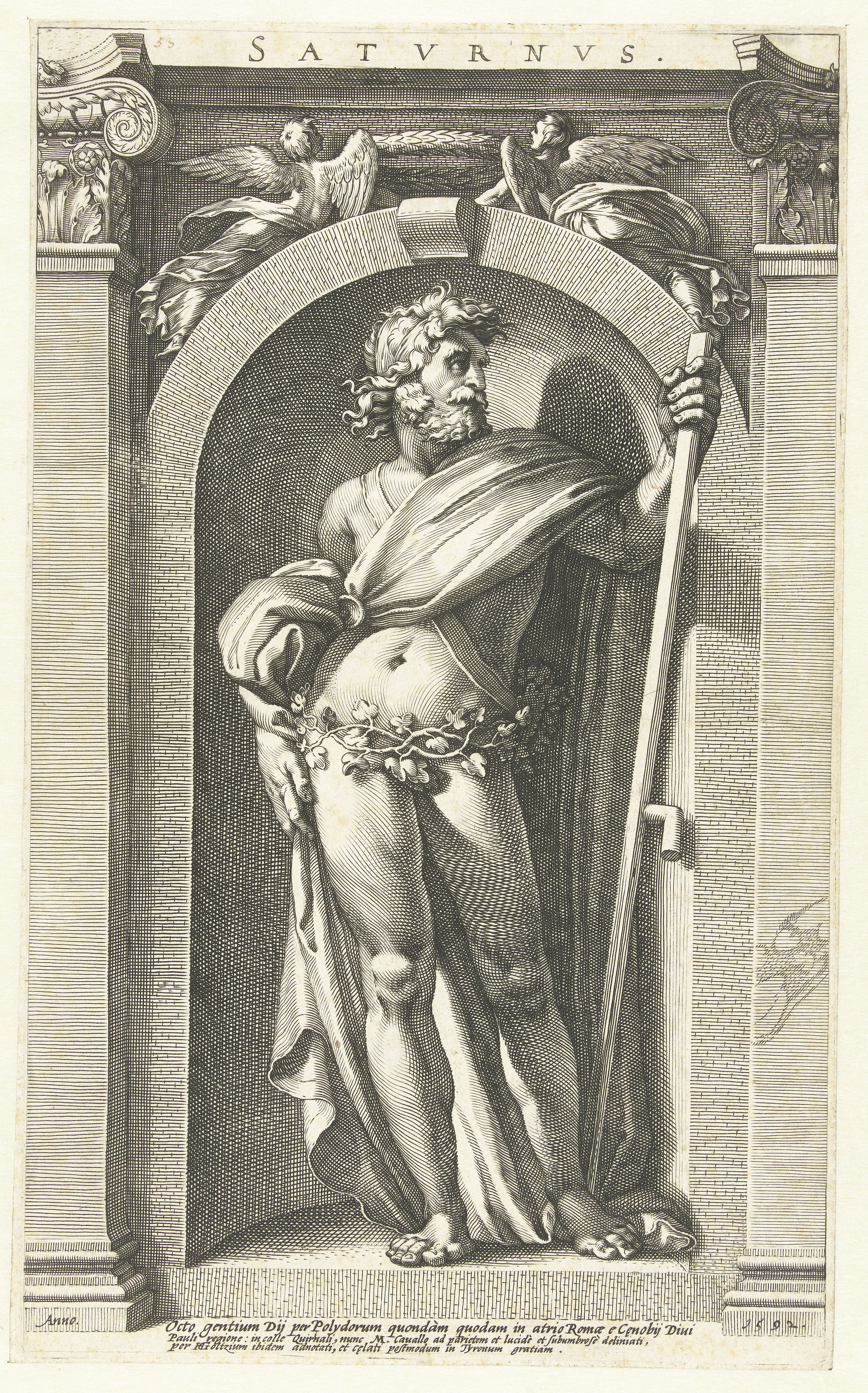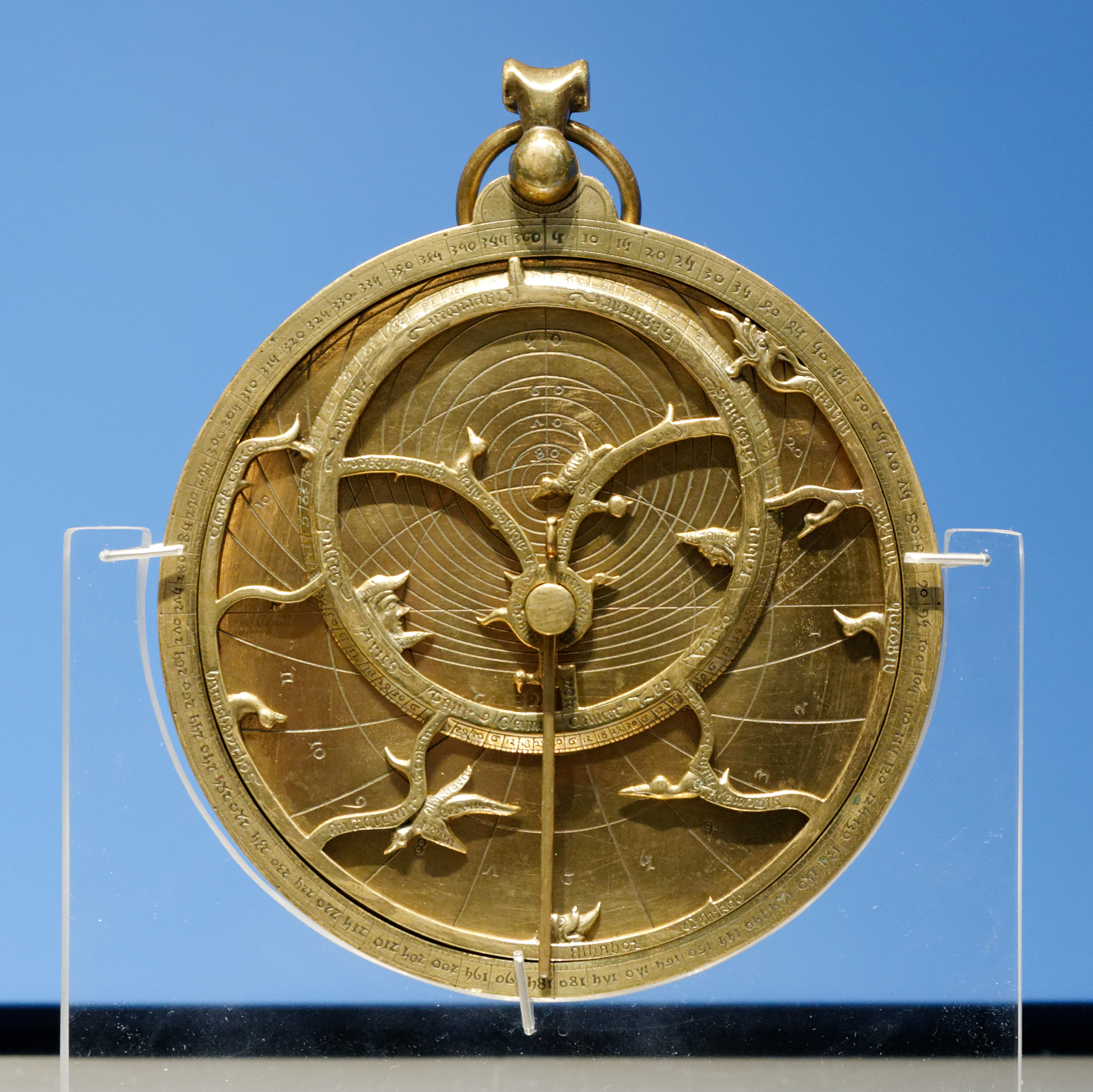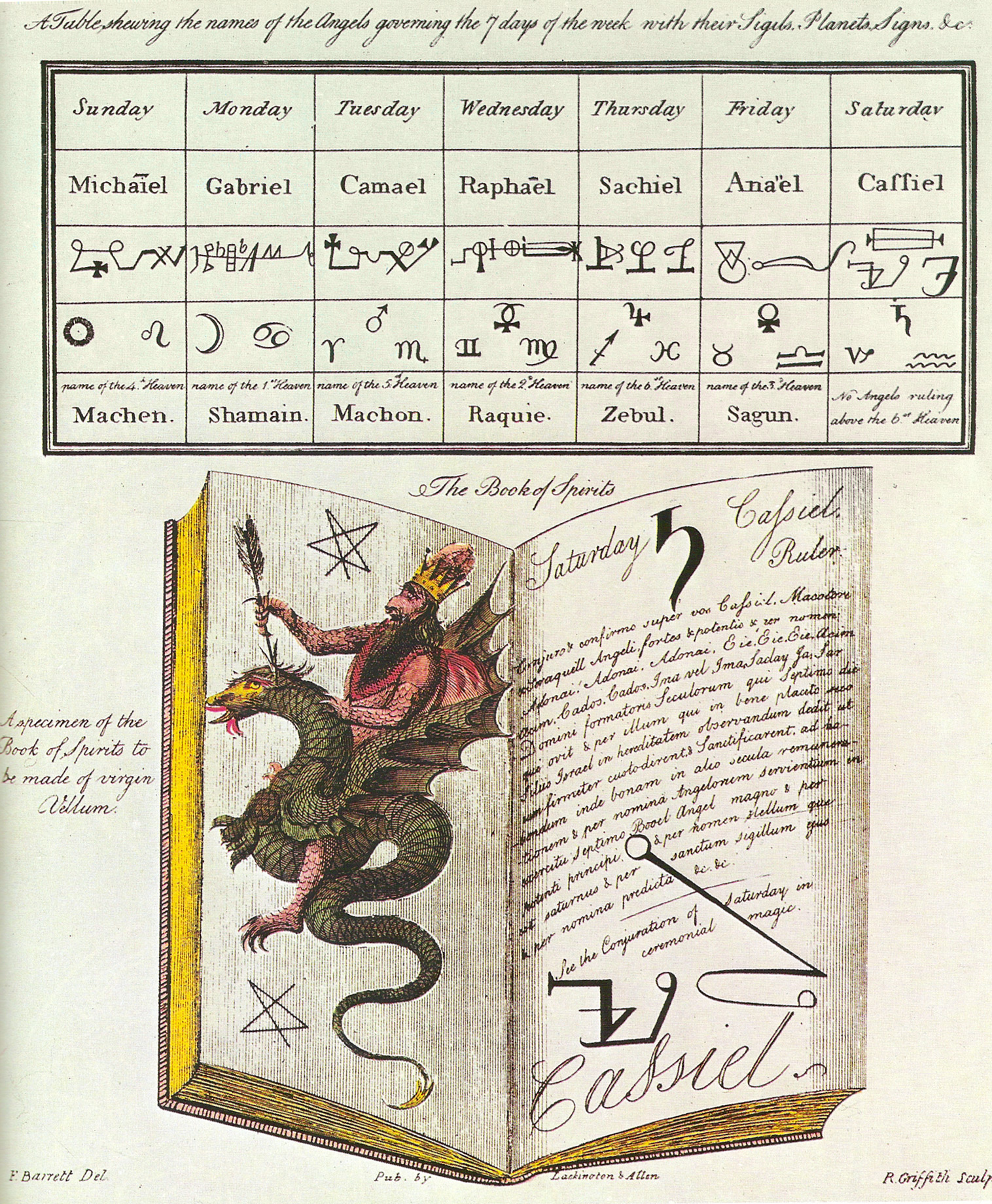|
Planetary Hours
The planetary hours are an ancient system in which one of the seven classical planets is given rulership over each day and various parts of the day. Developed in Hellenistic astrology, it has possible roots in older Babylonian astrology, and it is the origin of the names of the days of the week as used in English and numerous other languages. The classical planets are Saturn, Jupiter, Mars, Sun, the Sun, Venus, Mercury (planet), Mercury and Moon, the Moon, and they take rulership over the hours in this sequence. The sequence is from slowest- to fastest-moving as the planets appear in the night sky, and so is from furthest to nearest in the planetary spheres model. This order has come to be known as the "Chaldean order". As each day is divided into 24 hours, the first hour of a day is ruled by the planet three places down in the Chaldean order from the planet ruling the first hour of the preceding day; i.e. a day with its first hour ruled by the Sun ("Sunday") is followed by ... [...More Info...] [...Related Items...] OR: [Wikipedia] [Google] [Baidu] |
Classical Planets
In classical antiquity, the seven classical planets or seven luminaries are the seven moving astronomical objects in the sky visible to the naked eye: the Moon, Mercury, Venus, the Sun, Mars, Jupiter, and Saturn. The word ''planet'' comes from two related Greek words, πλάνης ''planēs'' (whence πλάνητες ἀστέρες ''planētes asteres'' "wandering stars, planets") and πλανήτης ''planētēs'', both with the original meaning of "wanderer", expressing the fact that these objects move across the celestial sphere relative to the fixed stars. Greek astronomers such as Geminus and Ptolemy often divided the seven planets into the Sun, the Moon, and the five planets. The term ''planet'' in modern terminology is only applied to natural satellites directly orbiting the Sun (or other stars), so that only five of the seven classical planets are planets in the modern sense. The same seven planets, along with the ascending and descending lunar node, are mentioned in ... [...More Info...] [...Related Items...] OR: [Wikipedia] [Google] [Baidu] |
Saturday
Saturday is the day of the week between Friday and Sunday. No later than the 2nd century, the Romans named Saturday ("Saturn's Day") for the planet Saturn, which controlled the first hour of that day, according to Vettius Valens. The day's name was introduced into West Germanic languages and is recorded in the Low German languages such as Middle Low German , ''saterdach'', Middle Dutch (Modern Dutch ) and Old English , ''Sæterndæġ'' or . Origins Between the 1st and 3rd centuries AD, the Roman Empire gradually replaced the eight-day Roman nundinal cycle with the seven-day week. The astrological order of the days was explained by Vettius Valens and Dio Cassius (and Chaucer gave the same explanation in his ''Treatise on the Astrolabe''). According to these authors, it was a principle of astrology that the heavenly bodies presided, in succession, over the hours of the day. The association of the weekdays with the respective deities is thus indirect, the days are named for th ... [...More Info...] [...Related Items...] OR: [Wikipedia] [Google] [Baidu] |
Jupiter Symbol (fixed Width)
A planet symbol (or ''planetary symbol'') is a graphical symbol used in astrology and astronomy to represent a classical planet (including the Sun and the Moon) or one of the modern planets. The symbols were also used in alchemy to represent the metals associated with the planets, and in calendars for their associated days. The use of these symbols derives from Classical Greco-Roman astronomy, though their current shapes are a development of the 16th century. The classical planets, their symbols, days and most commonly associated planetary metals are: The International Astronomical Union (IAU) discourages the use of these symbols in modern journal articles, and their style manual proposes one- and two-letter abbreviations for the names of the planets for cases where planetary symbols might be used, such as in the headings of tables. The modern planets with their traditional symbols and IAU abbreviations are: The symbols of Venus and Mars are also used to represent female and ... [...More Info...] [...Related Items...] OR: [Wikipedia] [Google] [Baidu] |
Saturn Symbol (fixed Width)
A planet symbol (or ''planetary symbol'') is a graphical symbol used in astrology and astronomy to represent a classical planet (including the Sun and the Moon) or one of the modern planets. The symbols were also used in alchemy to represent the metals associated with the planets, and in calendars for their associated days. The use of these symbols derives from Classical Greco-Roman astronomy, though their current shapes are a development of the 16th century. The classical planets, their symbols, days and most commonly associated planetary metals are: The International Astronomical Union (IAU) discourages the use of these symbols in modern journal articles, and their style manual proposes one- and two-letter abbreviations for the names of the planets for cases where planetary symbols might be used, such as in the headings of tables. The modern planets with their traditional symbols and IAU abbreviations are: The symbols of Venus and Mars are also used to represent female and ... [...More Info...] [...Related Items...] OR: [Wikipedia] [Google] [Baidu] |
Ptolemaic System
In astronomy, the geocentric model (also known as geocentrism, often exemplified specifically by the Ptolemaic system) is a superseded description of the Universe with Earth at the center. Under most geocentric models, the Sun, Moon, stars, and planets all orbit Earth. The geocentric model was the predominant description of the cosmos in many European ancient civilizations, such as those of Aristotle in Classical Greece and Ptolemy in Roman Egypt. Two observations supported the idea that Earth was the center of the Universe: * First, from anywhere on Earth, the Sun appears to revolve around Earth once per day. While the Moon and the planets have their own motions, they also appear to revolve around Earth about once per day. The stars appeared to be fixed on a celestial sphere rotating once each day about an axis through the geographic poles of Earth. * Second, Earth seems to be unmoving from the perspective of an earthbound observer; it feels solid, stable, and stationary. An ... [...More Info...] [...Related Items...] OR: [Wikipedia] [Google] [Baidu] |
Treatise On The Astrolabe
''A Treatise on the Astrolabe'' is a medieval instruction manual on the astrolabe by Geoffrey Chaucer. It describes both the form and the proper use of the instrument, and stands out as a prose technical work from a writer better known for poetry, written in English rather than the more typical Latin. Significance The ''Treatise'' is considered the "oldest work in English written upon an elaborate scientific instrument". It is admired for its clarity in explaining difficult concepts – although modern readers lacking an actual astrolabe may find the details of the astrolabe difficult to understand. Robinson believes that it indicates that had Chaucer written more freely composed prose it would have been superior to his translations of Boethius and Renaut de Louhans. Chaucer’s exact source is undetermined but most of his ‘conclusions’ go back, directly or indirectly, to ''Compositio et Operatio Astrolabii'', a Latin translation of Messahala's Arabic treatise of the 8 ... [...More Info...] [...Related Items...] OR: [Wikipedia] [Google] [Baidu] |
Chaucer
Geoffrey Chaucer (; – 25 October 1400) was an English poet, author, and civil servant best known for '' The Canterbury Tales''. He has been called the "father of English literature", or, alternatively, the "father of English poetry". He was the first writer to be buried in what has since come to be called Poets' Corner, in Westminster Abbey. Chaucer also gained fame as a philosopher and astronomer, composing the scientific ''A Treatise on the Astrolabe'' for his 10-year-old son Lewis. He maintained a career in the civil service as a bureaucrat, courtier, diplomat, and member of parliament. Among Chaucer's many other works are ''The Book of the Duchess'', ''The House of Fame'', ''The Legend of Good Women'', and ''Troilus and Criseyde''. He is seen as crucial in legitimising the literary use of Middle English when the dominant literary languages in England were still Anglo-Norman French and Latin. Chaucer's contemporary Thomas Hoccleve hailed him as "the firste fyndere of ou ... [...More Info...] [...Related Items...] OR: [Wikipedia] [Google] [Baidu] |
Dio Cassius
Lucius Cassius Dio (), also known as Dio Cassius ( ), was a Roman historian and senator of maternal Greek origin. He published 80 volumes of the history on ancient Rome, beginning with the arrival of Aeneas in Italy. The volumes documented the subsequent founding of Rome (753 BC), the formation of the Republic (509 BC), and the creation of the Empire (27 BC), up until 229 AD. Written in Ancient Greek over 22 years, Dio's work covers approximately 1,000 years of history. Many of his 80 books have survived intact, or as fragments, providing modern scholars with a detailed perspective on Roman history. Biography Lucius Cassius Dio was the son of Cassius Apronianus, a Roman senator and member of the gens Cassia, who was born and raised at Nicaea in Bithynia. Byzantine tradition maintains that Dio's mother was the daughter or sister of the Greek orator and philosopher, Dio Chrysostom; however, this relationship has been disputed. Although Dio was a Roman citizen, he wrote in Gree ... [...More Info...] [...Related Items...] OR: [Wikipedia] [Google] [Baidu] |
Vettius Valens
Vettius Valens (120 – c. 175) was a 2nd-century Hellenistic astrologer, a somewhat younger contemporary of Claudius Ptolemy. Valens' major work is the ''Anthology'' ( la, Anthologia), ten volumes in Greek written roughly within the period 150 to 175. The ''Anthology'' is the longest and most detailed treatise on astrology which has survived from that period. A working professional astrologer, Valens includes over a hundred sample charts from his case files in the ''Anthology''. Travels Although originally a native of Antioch, he appears to have travelled widely in Egypt in search of specific astrological doctrines to bolster his practice. At the time Alexandria was still home to a number of astrologers of the older Babylonian, Greek and Egyptian traditions. He published much of what he learned from the tradition and through his practice in his ''Anthology'', written in an engaging and instructional style. The ''Anthology'' is thus of great value in piecing together actual ... [...More Info...] [...Related Items...] OR: [Wikipedia] [Google] [Baidu] |
Days Of The Week
A day is the time period of a full rotation of the Earth with respect to the Sun. On average, this is 24 hours, 1440 minutes, or 86,400 seconds. In everyday life, the word "day" often refers to a solar day, which is the length between two solar noons or times the Sun reaches the highest point. The word "day" may also refer to '' daytime'', a time period when the location receives direct and indirect sunlight. On Earth, as a location passes through its day, it experiences morning, noon, afternoon, evening, and night. The effect of a day is vital to many life processes, which is called the circadian rhythm. A collection of sequential days is organized into calendars as dates, almost always into weeks, months and years. Most calendars' arrangement of dates use either or both the Sun with its four seasons ( solar calendar) or the Moon's phasing (lunar calendar). The start of a day is commonly accepted as roughly the time of the middle of the night or midnight, written as 0 ... [...More Info...] [...Related Items...] OR: [Wikipedia] [Google] [Baidu] |
The Magus (handbook)
''The Magus, or Celestial Intelligencer'' is a handbook of the occult and ceremonial magic compiled by occultist Francis Barrett published in 1801. Contents and Sources Much of the material was actually collected by Barrett from older occult handbooks, as he hints in the preface: We have collected out of the works of the most famous magicians, such as Zoroaster, Hermes, Apollonius, Simon of the Temple, Trithemius, Agrippa, Porta (the Neapolitan), Dee, Paracelsus, Roger Bacon, and a great many others... In fact, most of the material comes from Agrippa's ''Three Books of Occult Philosophy'' and Pietro d'Abano's ''Heptameron''. Previous demonologists such as Binsfeld (1589) had drawn up lists that comprised a hierarchy of devils, and attributed them with the power to instigate people to commit the seven deadly sins. Lucifer was associated with Pride, Satan with Anger and so forth. In ''The Magus'' Barrett altered the "roster of devils" and Satan now became a prince of deluders ... [...More Info...] [...Related Items...] OR: [Wikipedia] [Google] [Baidu] |
Equinoxes
A solar equinox is a moment in time when the Sun crosses the Earth's equator, which is to say, appears directly above the equator, rather than north or south of the equator. On the day of the equinox, the Sun appears to rise "due east" and set "due west". This occurs twice each year, around 20 March and 23 September. More precisely, an equinox is traditionally defined as the time when the plane of Earth's equator passes through the geometric center of the Sun's disk. Equivalently, this is the moment when Earth's rotation axis is directly perpendicular to the Sun-Earth line, tilting neither toward nor away from the Sun. In modern times, since the Moon (and to a lesser extent the planets) causes Earth's orbit to vary slightly from a perfect ellipse, the equinox is officially defined by the Sun's more regular ecliptic longitude rather than by its declination. The instants of the equinoxes are currently defined to be when the apparent geocentric longitude of the Sun is 0° and 1 ... [...More Info...] [...Related Items...] OR: [Wikipedia] [Google] [Baidu] |




